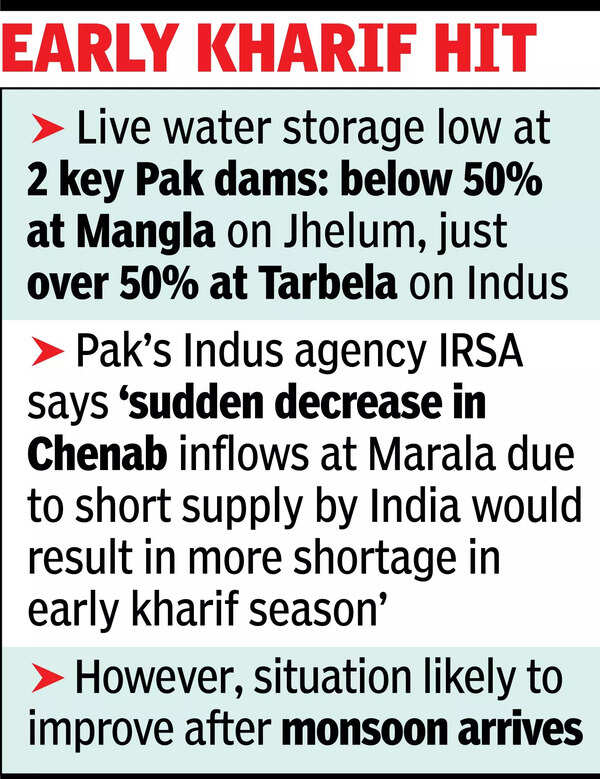NEW DELHI: Pakistan is staring at a bleak kharif (summer crops) sowing season with a major dip in live storage at its two key dams – Mangla on river Jhelum and Tarbela on Indus – and the “sudden decrease” in Chenab river inflows due to regulation of water flow by India in the aftermath of the Pahalgam terror attack.The situation may further aggravate this month during early kharif sowing and this is possibly what prompted Pakistani PM Shehbaz Sharif to raise concerns at a conference on glacier preservation in Dushanbe, Tajikistan, last week to draw global attention to India’s decision to suspend the Indus Waters Treaty.Latest estimates by Pakistan’s Indus River System Authority (IRSA) show the country is already facing an overall shortage of 21% in water flow and around 50% in live storage of the two key dams which play a crucial role in providing water for irrigation in Punjab and Sindh provinces of Pakistan and generating hydropower.Referring to its latest assessment of availability of water for summer sowing operations during May-Sept, the IRSA in its statement “noted with concern” that the “sudden decrease in river Chenab inflows at Marala due to short supply by India would result in more shortage in early kharif season”.

It declared an overall shortage of 21% and advised dam authorities and irrigation supply monitoring agencies to use water from reservoirs judiciously, “keeping in view the crisis created by Indian short supplies in Chenab river”.Though the situation may improve with monsoon rainfall in the catchment area, possibly by next month, Pakistan’s farming operations will depend more on how India regulates the flow through limited infrastructure of its own reservoirs – Baglihar and Salal – on the Chenab in Jammu and Kashmir.India has, so far, only flushed these reservoirs and made additional water storage available by clearing sediments. Besides, it also stopped sharing water flow data with Pakistan after putting the 1960 treaty in abeyance following the Pahalgam massacre.Publicly available information on live storage of Pakistan’s critical reservoirs shows that Mangla dam is currently left with less than 50% of its fill level (2.7 million acre feet out of the total capacity of 5.9 MAF) whereas Tarbela dam’s live storage is slightly over 50% (6 MFA) of its total capacity of 11.6 MFA. Officials here believe that since India is under no obligation to share water flow data with Pakistan after suspending the IWT, it would be difficult for the neighbouring country to even manage floods during the peak flow season once monsoon hits the catchment areas of the Indus river system as a large part of it falls within India. Farming operations in two provinces of Pakistan, Punjab and Sindh, fully depend on irrigation canals linked to the Indus river system, which gets almost its entire waters from the western rivers — Indus, Jhelum and Chenab. Though India has full rights on the waters of eastern rivers (Ravi, Sutlej and Beas) under the IWT, inadequate infrastructure to use the waters by the Indian side benefits Pakistan. India is permitted to construct water storage facilities on western rivers up to 3.6 MAF but has not been able to fully utilise this, making Pakistan a beneficiary by default.

